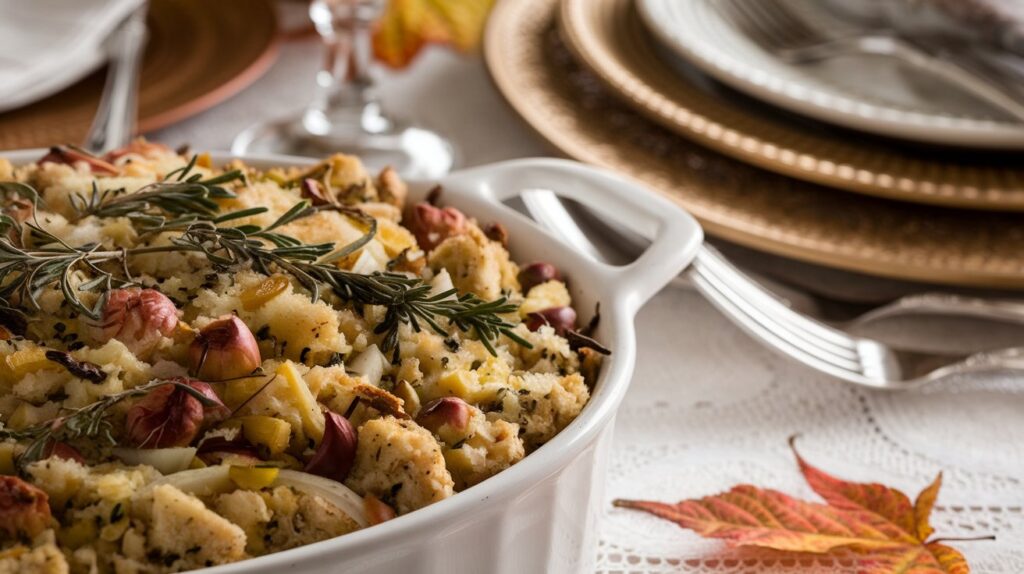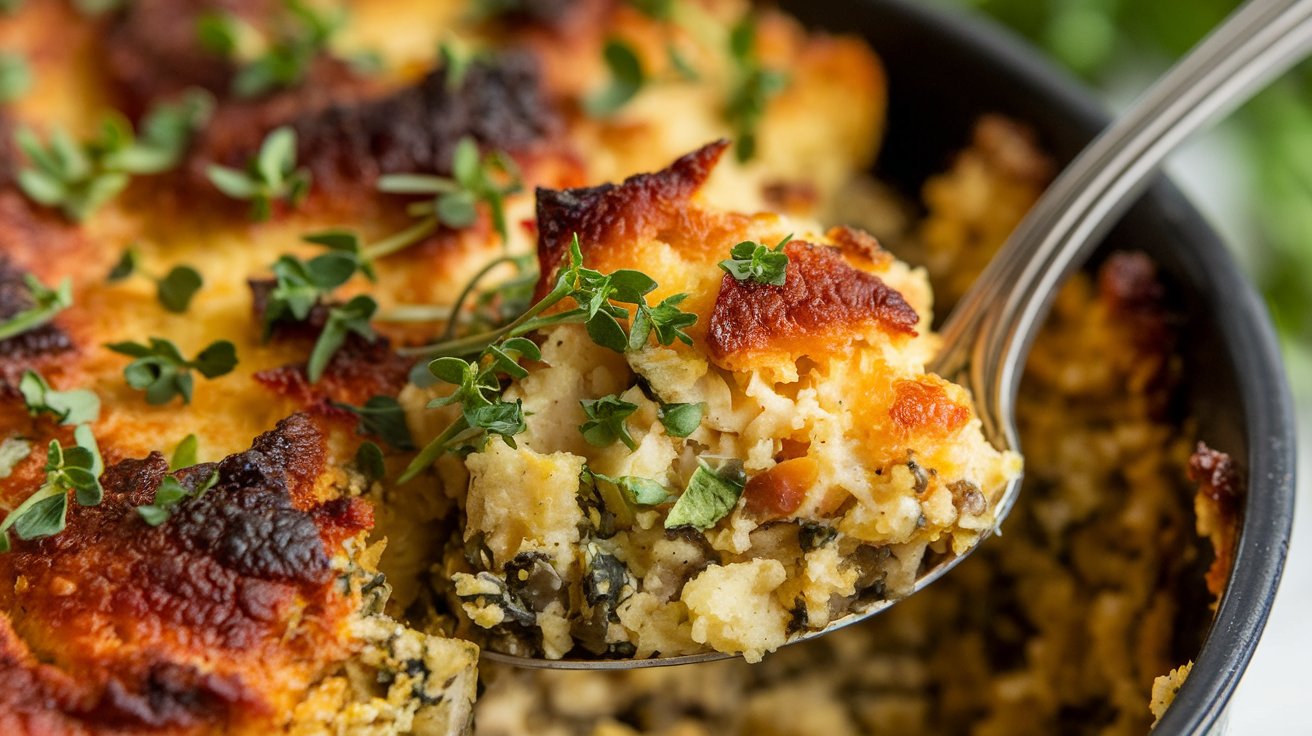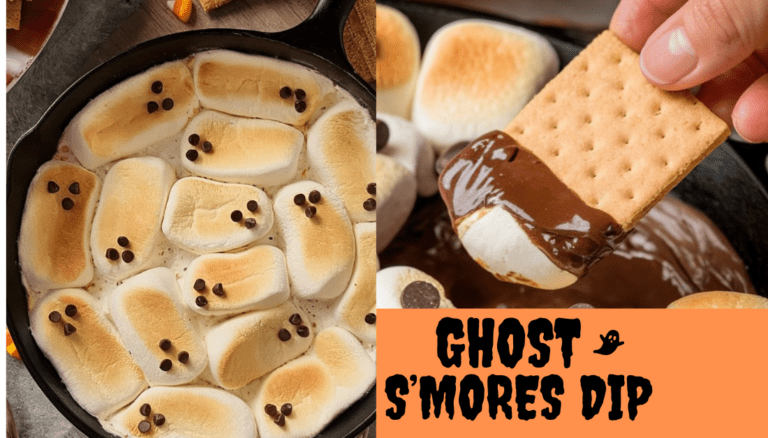Grandma’s Turkey Stuffing Recipe for Thanksgiving
As Thanksgiving gets closer, Grandma’s Turkey Stuffing Recipe always brings back warm memories. This homemade stuffing is a big part of holiday meals, bringing families together. It’s filled with the delicious smells of herbs and bread.
Every bite takes you back in time, filled with joy and love. If you want to make your Thanksgiving dinner special, try this classic stuffing. It’s sure to make memories that last a lifetime.
The Heart of Thanksgiving: Turkey Stuffing
Turkey stuffing is a key part of Thanksgiving in the United States. It makes Thanksgiving dinner special. This dish, often inside the turkey, shows the holiday’s spirit of togetherness and thanks.
For generations, families have come together. They share stories and laughter, with turkey stuffing at the center. It’s the flavorful heart of their celebrations.
Believe it or not — stuffing’s history goes back to ancient times! Then, it was used to make meats taste better. Over time, it has changed, showing off different tastes and traditions.
Now, stuffing can be made in many, many ways. Some recipes use herbs, while others add fruits and nuts. This variety shows how diverse American food is.
Every family has its own stuffing recipe. These recipes are special because they come from personal traditions. When families gather, stuffing reminds them of their connections. It’s more than food; it’s about community and love.

Essential Ingredients for Grandma’s Turkey Stuffing
Grandma’s turkey stuffing is all about the mix of flavors from different ingredients. These ingredients make up the traditional stuffing that’s a big part of Thanksgiving. Each one adds something special, making the stuffing a hit at family gatherings.
Key Ingredients You’ll Need
To make a comforting stuffing, start with these basic ingredients:
- Stale bread – Provides structure and absorbs flavors.
- Chicken broth – Moistens the stuffing and infuses richness.
- Onions – Adds sweetness and depth.
- Celery – Offers a crunchy texture and freshness.
- Butter – Enhances richness and flavor.
- Spices – Salt, pepper, and sage elevate the dish’s overall taste.
Optional Ingredients to Enhance Flavor
For a personalized touch, add these ingredients to bring more flavor:
- Diced apples – Adds a hint of sweetness.
- Dried cranberries – Infuses tartness and color.
- Nuts such as walnuts or pecans – Provide texture and crunch.
- Herbs like parsley and rosemary – Add freshness and complexity.
| Ingredient | Function |
|---|---|
| Stale bread | Foundation and texture |
| Chicken broth | Moistens and enriches flavor |
| Onions | Adds sweetness |
| Celery | Crunch and freshness |
| Butter | Richness and flavor |
| Spices | Taste enhancer |
| Diced apples | Sweetness |
| Dried cranberries | Tartness |
| Nuts | Texture |
| Herbs | Freshness |
Preparing the Best Turkey Stuffing
Making the perfect turkey stuffing takes a few important steps. By following these steps, you’ll create a dish that’s a hit at any Thanksgiving table. Here’s a detailed guide to making a stuffing that will impress your guests.
Step-by-Step Instructions
- Begin by drying your bread. Cut it into cubes and let it sit out for a few hours. Or, bake it in a low oven until it’s crisp.
- While the bread cools, cook chopped onions, celery, and garlic in butter until they’re soft.
- In a big bowl, mix the dried bread cubes with the cooked vegetables. Add herbs and spices as you like.
- Slowly add broth until the stuffing is moist but not too wet.
- Put the mixture in a baking dish and cover it with foil. Bake it when your turkey is ready for the best flavor.
Tips for Perfect Texture
Getting the right texture in your turkey stuffing is key. You want it to be moist but not soggy. Here are some tips to help:
- Use a mix of broth and sautéed veggies for moisture without being too wet.
- Mix the ingredients gently so they’re evenly spread.
- Check the stuffing before baking. It should be moist but not mushy. Add more broth if it’s too dry.
- Bake it uncovered for the last 15 minutes. This will give it a crispy top layer.
Variations of Turkey Stuffing
Exploring different turkey stuffing variations can make your Thanksgiving dish special. Adding nuts and herbs brings exciting flavors and textures. This makes your stuffing unforgettable.
Nut Variations: Walnuts, Pecans, or Chestnuts?
Nuts add a delightful crunch and rich flavor to turkey stuffing. Here are some nutty options:
- Walnuts: Known for their earthy taste, walnuts provide a bold flavor and a pleasant crunch. They pair well with savory ingredients.
- Pecans: These nuts offer a sweeter profile, bringing a subtle richness that balances the savory elements of the stuffing.
- Chestnuts: A classic choice, chestnuts have a unique, slightly sweet flavor and creamy texture, perfect for a holiday feel.
Feel free to experiment with these nut variations in stuffing based on your family’s preferences. Adding nuts to turkey stuffing not only enhances the flavor but also brings in added nutrition.
Herb Variations: Thyme, Sage, and Beyond
Herbs play a crucial role in flavoring your turkey stuffing. Traditional herbs like thyme and sage are excellent for creating comforting, aromatic sensations. Explore these flavorful herbs:
- Thyme: Offers a subtle earthy taste that complements poultry beautifully. Use fresh thyme for a vibrant flavor.
- Sage: Its strong flavor can be overwhelming, so use sparingly. It works wonders with other stuffing ingredients.
- Rosemary: Adds a pine-like freshness, ideal for those looking for a bolder herb option.
- Parsley: Brings brightness and balance to the stuffing. Use it as a garnish for an attractive presentation.
Experimenting with different herbs can introduce unique and flavorful twists to your turkey stuffing. Use these herb variations for flavorful stuffing to bring new life to a traditional recipe.
| Nut Type | Flavor Profile | Texture |
|---|---|---|
| Walnuts | Earthy | Crispy |
| Pecans | Sweet | Crunchy |
| Chestnuts | Nutty and Sweet | Creamy |
Gluten-Free Options for Turkey Stuffing
Looking to make Grandma’s turkey stuffing gluten-free? There are great alternatives that keep the flavor and texture. With Gluten-Free Bread Options and grains, making stuffing is now easier than ever.
Using Gluten-Free Bread
For gluten-free bread, pick brands like Udi’s and Schär. They’re close to traditional bread. Cut the bread into cubes and dry them for a few hours. This makes the stuffing feel just right.
Don’t forget to add herbs and spices for extra flavor. To keep it moist, mix in stock or broth. This makes every bite delicious.
Alternative Grains for Flavorful Stuffing
Try using quinoa, rice, or cornbread for a gluten-free stuffing. Quinoa adds a nutty taste and light feel. Rice makes it heartier.
Follow the package to cook these grains. Then, mix them with sautéed veggies, herbs, and spices. This boosts the flavor. Remember, the right seasonings make each bite perfect.

Cooking Techniques for the Perfect Stuffing
Choosing the right cooking method is key to making the perfect turkey stuffing. Two popular methods are oven-baked and stove-top stuffing recipes. Each has its own benefits, catering to different tastes.
Oven-Baked vs. Stove-Top Cooking
Oven-baked stuffing gets a crispy top, adding a nice contrast to its moist inside. Stove-top stuffing, on the other hand, cooks faster. It also infuses flavors directly in the pan, making it rich and hearty. Here’s a look at both methods:
| Aspect | Oven-Baked Stuffing | Stove-Top Stuffing |
|---|---|---|
| Texture | Crispy on top, moist inside | Soft and creamy |
| Cook Time | Longer, around 30-45 minutes | Quicker, usually 15-20 minutes |
| Flavor Development | Complex flavors from baking | Intense flavors from stovetop cooking |
| Preparation Difficulty | Requires baking dish and time | Simple, often a single pan |
Timing Your Stuffing for Optimal Flavor
Timing is everything for stuffing. For oven-baked, preheat and bake until golden. It usually takes 30 to 45 minutes, depending on size. Stove-top methods involve sautéing onions and other ingredients before adding stock. This enhances the flavor.
Plan your cooking times to match the turkey’s. Your stuffing should be ready to serve alongside the turkey. This way, you can present a meal that’s full of flavor. Remember to check the internal temperature and avoid overcooking. This keeps the stuffing’s aroma and taste fresh.

Serving Suggestions for Your Turkey Stuffing
Creating a well-rounded Thanksgiving meal can make your dining experience better. Pairing your stuffing with other dishes brings balance and enhances flavors. Here are some ideas to consider.
Complementary Dishes
Choosing the right dishes to serve with stuffing can make your Thanksgiving plate shine. Here are some dishes to serve with stuffing for a complete meal:
- Roasted Vegetables: A mix of seasonal vegetables adds color and nutrition.
- Mashed Potatoes: Creamy potatoes provide a comforting base for stuffing.
- Cranberry Sauce: The tart sweetness complements the savory flavors of stuffing.
- Green Bean Casserole: A classic dish that adds crunch and richness.
- Gravy: Pouring gravy over turkey and stuffing unites the flavors.
Garnishes and Sauces to Enhance Flavor
Garnishing your turkey stuffing not only makes it look better but also boosts flavor. Here are some ideas for garnish ideas for stuffing and sauces that can elevate your dish:
- Fresh herbs like parsley or thyme provide a burst of freshness.
- A drizzle of homemade gravy creates a cohesive flavor profile.
- Toasted nuts offer texture and a nutty flavor that pairs well.
- Citrus zest lifts the dish with a hint of brightness.
- Caramelized onions add sweetness and depth.
| Dish | Complementing Flavor | Serving Style |
|---|---|---|
| Roasted Vegetables | Earthy and Sweet | Family-style |
| Mashed Potatoes | Rich and Creamy | Piped or scooped |
| Cranberry Sauce | Tart and Sweet | On the side |
| Green Bean Casserole | Crispy and Savory | In a serving dish |
| Gravy | Savory | In a gravy boat |
These Thanksgiving plate pairings create a delightful balance of flavors and textures. They ensure everyone enjoys their serving of turkey stuffing. By carefully choosing complementary dishes and garnishes, your Thanksgiving meal can become a memorable feast.
Storing and Reheating Leftover Turkey Stuffing
It’s important to handle leftover turkey stuffing safely and keep it tasty. Follow these Turkey Stuffing Storage Tips to keep your stuffing fresh and delicious for days.
Best Storage Practices
Storing leftover stuffing right is key to keeping it fresh. Here’s how:
- Let the stuffing cool down completely before storing to avoid moisture buildup.
- Put the stuffing in airtight containers or resealable bags. This stops air from getting in and causing spoilage.
- Write the date on your containers so you know when to eat it. Try to use it within 3 to 4 days.
- If you want to keep it longer, freeze the stuffing. It can stay good for up to 2 months in the freezer.
How to Safely Reheat Stuffing
When you’re ready to eat leftover stuffing again, use these safe reheating tips:
- Oven Method: Heat the oven to 350°F (175°C). Put the stuffing in a dish, cover it with foil, and heat for 20-30 minutes. It should be 165°F (74°C) inside.
- Microwave Method: Use a microwave-safe dish for the stuffing. Cover it with a damp paper towel to keep it moist. Heat in short bursts, stirring between each one, until it’s warm all the way through.

By storing and reheating your stuffing the right way, you can enjoy it even after Thanksgiving. Make the most of the tasty stuffing Grandma made!
Why Grandma’s Recipe is a Thanksgiving Staple
Grandma’s Turkey Stuffing is at the heart of Family Traditions Thanksgiving. Every year, family members look forward to enjoying this beloved dish together. It’s not just about the taste; it’s about the bond it creates across generations.
The recipe has been passed down, carrying cultural values and family love. It’s a symbol of the family’s history and tradition.
The Family Tradition Behind the Recipe
Every bite of Grandma’s Turkey Stuffing brings back cherished memories. It reminds us of the joy and laughter in family kitchens. It’s more than a meal; it’s a tradition that brings comfort and teaches us about our heritage.
Memorable Stories and Anecdotes
Thanksgiving is filled with stories of the stuffing’s preparation and enjoyment. Tales of kitchen mishaps and laughter bring everyone closer. These stories make the stuffing a key part of the holiday.
These memories show how food brings us together and fills us with gratitude. They are a big part of our family’s history and tradition.
Tips for Making Turkey Stuffing Ahead of Time
Making turkey stuffing ahead of time can save you a lot of time on Thanksgiving. With a few Make Ahead Stuffing Tips, you can enjoy the process more. Start by preparing ingredients the day before to make your Turkey Stuffing Prep easier.
Think about chopping veggies, measuring spices, and toasting breadcrumbs early. This can cut down your cooking time on the big day. You’ll have more time to focus on your turkey and other dishes.
If you want to put the stuffing together early, do it the night before. Keep it in an airtight container in the fridge. When it’s time to cook, remember to add 15-20 minutes to the oven time. This is because the stuffing will be cold.
Here’s a quick table summarizing essential tips for Preparing Stuffing in Advance:
| Tip | Description |
|---|---|
| Chop Ingredients | Prepare vegetables and herbs a day ahead to save time. |
| Measure Spices | Organize and measure out spices for easy access when cooking. |
| Toast Bread | Toast breadcrumbs a day in advance for enhanced flavor. |
| Full Assembly | Assemble stuffing completely and refrigerate overnight. |
| Adjust Timing | Add 15-20 minutes to baking time if chilled. |
These simple strategies will make your Turkey Stuffing Prep easier. They ensure a delicious dish for your Thanksgiving feast. Whether it’s your first time or a family tradition, these tips will make it fun. For more Thanksgiving recipes and tips, check out this resource.







